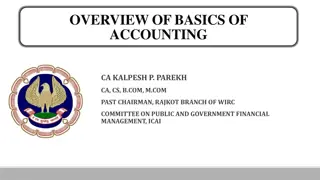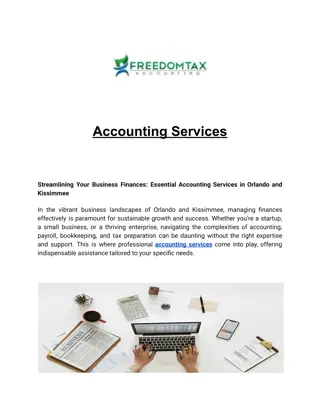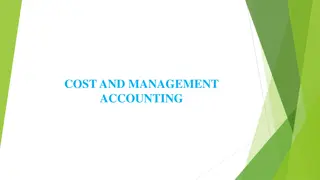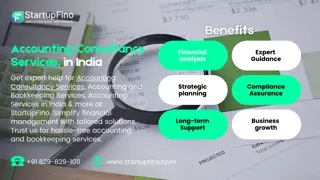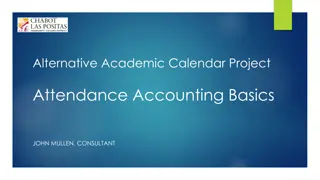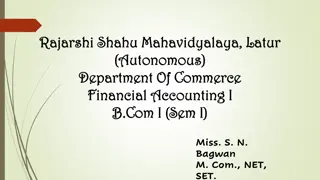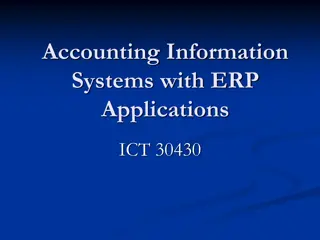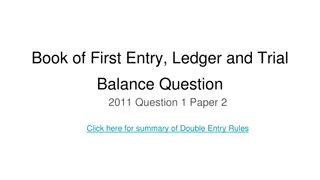Introduction to Principles of Accounts Level 1: Basics of Accounting and Bookkeeping
Understanding the fundamentals of accounting including bookkeeping, classification of data, users of accounting information, assets, liabilities, and capital. Practice exercises to classify items and review concepts of assets, liabilities, and equity.
Download Presentation

Please find below an Image/Link to download the presentation.
The content on the website is provided AS IS for your information and personal use only. It may not be sold, licensed, or shared on other websites without obtaining consent from the author.If you encounter any issues during the download, it is possible that the publisher has removed the file from their server.
You are allowed to download the files provided on this website for personal or commercial use, subject to the condition that they are used lawfully. All files are the property of their respective owners.
The content on the website is provided AS IS for your information and personal use only. It may not be sold, licensed, or shared on other websites without obtaining consent from the author.
E N D
Presentation Transcript
Principles of Accounts Level 1 Introduction
Book-keeping vs Accounting Book-keeping: Recording of financial data Accounting: Classifying the data, summarizing data and communicating the information
Assets, Liabilities & Capital Assets: resources owned by the business Liabilities: resourced owned by the business for which the business still owes Capital/Owner s Equity: resources supplied to the business by its owner/owners
Lets practice A = L + C C = A - L L = A - C
More practice Assets $12,500 $25,500 $16,800 $51,400 Liabilities $1,800 $6,300 $4,300 $11,650 Capital $10,700 $19,200 $12,500 $39,750
Classify the following into Assets, Liabilities or Capital Motor Vehicles - ASSET Creditors/Accounts Payable - LIABILITIES Cash - ASSET Buildings - ASSET Stock of Goods/Inventory - ASSET Debtors/Accounts Receivables - ASSET Land - ASSET Loan - LIABILITY Expenses owing - LIABILITY
Double Entry Record-Keeping Next class
But first, lets review! Assets Liabilities Capital/Owner s Equity $38,100 $34,400 $28,500 $4,100 $62,000 $110,000 A B C D E F $55,000 $51,600 $36,100 $19,500 $88,000 $159,000 $16,900 $17,200 $7,600 $15,400 $26,000 $49,000
More review! Classify the following items into assets and liabilities: Motor Vehicles Premises Accounts Payable Inventory Accounts Receivable Owing to bank Cash in hand Loan from D. Jones Machinery ASSET LIABILITIES CAPITAL ASSET LIABILITIES CAPITAL ASSET LIABILITIES CAPITAL ASSET LIABILITIES CAPITAL ASSET LIABILITIES CAPITAL ASSET LIABILITIES CAPITAL ASSET LIABILITIES CAPITAL ASSET LIABILITIES CAPITAL ASSET LIABILITIES CAPITAL
The accounting equation and the Balance Sheet/Statement of Financial Position The whole of accounting is based on the accounting equation The two sides of the accounting equation are represented by the two sections of the Statement of Financial Position The Statement of Financial Position is a financial statement prepared at a particular point in time and it shows assets, liabilities and capital or owner s equity The two totals of each part of the statement of financial position should always agree or balance Every transaction affects TWO items in the accounting equation or the same item TWICE.
Equality and the Accounting Equation Type of Transaction Effect Owner pays capital into bank Increase in asset (Bank) Purchase of shop premises by cheque Buy goods on credit Increase in asset (Inventory) Effect Increase in capital Increase in asset (Shop Premises) Increase in liability (Accounts Payable) Increase in Asset (Accounts Receivable) Decrease in asset (Inventory) Decrease in liability (Accounts Payable) Decrease in asset (Accounts Receivable) 1 2 Decrease in asset (Bank) 3 4 Sale of goods on credit Decrease in asset (Inventory) 5 6 Sale of goods for cash or cheque Pay supplier with cheque Increase in asset (Cash or Bank) Decrease in asset (Bank) 7 Customer pays money owing by cheque Increase in asset (Bank)
Now its your turn to practice Type of Transaction We pay a supplier $700 in cash Effect Cash is decreasing (Asset) Effect Accounts Payable is decreasing (Liability) Decrease in bank (Asset) Increase in Accounts Payable (Liability) Capital is increasing (Capital) Bank is decreasing (Asset) 1 2 3 We bought fixtures paying $2,000 by cheque We bought goods $2,750 on credit Increase in fixtures (Asset) Inventory is increasing (Asset) Cash in increasing (Asset) 4 The proprietor introduces another $5,000 cash into the firm J. Walker lends the firm $500 by cheque 5 Loans Payable J Walker is increasing (Liability) Returns Outwards (Inventory) is decreasing (Asset) Increase in Premises (Asset) Increase in Bank (Asset) 6 We return goods costing $600 to a supplier whose bill we had not paid Accounts Payable is increasing (Liability) 7 We bought additional shop premises paying $50,000 by cheque A customer pays us $500 by cheque Decrease in Bank (Asset) 8 Accounts Receivable is decreasing (Asset)
Double Entry Rules Accounts To record Entry in Account Increase DEBIT ASSETS Decrease CREDIT Increase CREDIT LIABILITIES Decrease DEBIT Increase CREDIT CAPITAL Decrease DEBIT
Lets practice the Double Entry Rules Account to DEBIT Motor Van Office Machinery Account to CREDIT Cash J. Grant & Sons 1. Bought motor van for cash 2. Bought office machinery on credit from J. Grant & Sons 3. Introduced capital in cash 4. A customer, J. Beach, pays us by cheque Cash Bank Capital Accounts Payable: J. Beach 5. Paid a supplier, A. Barret in cash 6. Sold office machinery for cash 7. Returned machinery to J. Grant & Sons
Ex. 6.3X Class Practice Transactions Account to be Debited Account to be Credited 1 2 Bought office machinery on credit from D. Issacs Ltd. Paid a supplier, C. Jones, from owner s private monies outside the firm. A customer, N. Fox, paid us in cash. Repaid part of loan from P. Exeter by cheque. Returned some of the office machinery to D. Isaacs Ltd. A customer, N. Lyn, pays us by cheque. Bought motor van by cash 3 4 5 6 7
Ex. 6.4 Home-Work Transactions Account to be Debited Motor Lorry T. Lee P. Lopez Cash in Hand Office Machinery Cash Cash at Bank Cash at Bank Cash D. Lord Account to be Credited Cash Cash at Bank Cash in Hand Motor Lorry Ultra Ltd. A. Hill J. Cross Capital L. Lowe Cash A B C D E F G H I J Bought motor lorry for cash Paid supplier, T. Lee, by cheque Repaid P. Lopez s loan for cash Sold motor lorry for cash Bought office machinery on credit from Ultra Ltd. A customer, A. Hill, pays us by cash A customer, J. Cross, pays us by cheque Put a further amount into the business by cheque A loan of $200 in cash is received from L. Lowe Paid a supplier, D. Lord, by cash
Ex. 6.2 and 6.5 Practice Transactions Account to be Debited Machinery A. Jackson & Son Cash Bank Cash Cash Motor Van Office Machinery Account to be Credited A. Jackson & Son Machinery J. Brown J. Smith Office Machinery Capital Speed & Sons Cash A B C D E F G H Bought machinery on credit from A. Jackson & Son Returned machinery to A. Jackson & Son A customer, J. Brown, pays us in cash J. Smith lends us money, giving it to us by cheque Sold office machinery for cash Started business with cash Bought motor van on credit from Speed & Sons Bought office machinery by cash from Duplicators Ltd.
T-Accounts EXAMPLE OF T ACCOUNT Name of Account (A/c) Date Details $Date Details $ DEBIT SIDE CREDIT SIDE
Home-Work practice for next class Exercises 6.6 and 6.8X To be completed in your notebooks. Students must use rulers to draw all lines. No white out or correction pens are allowed.
Home-Work practice for next class Read chapter 7: Asset of Inventory Prepare for an in-class quiz on all completed so far: Definition and Users of Accounting information, Accounting Equation, Double Entry Rules and T-Accounts





